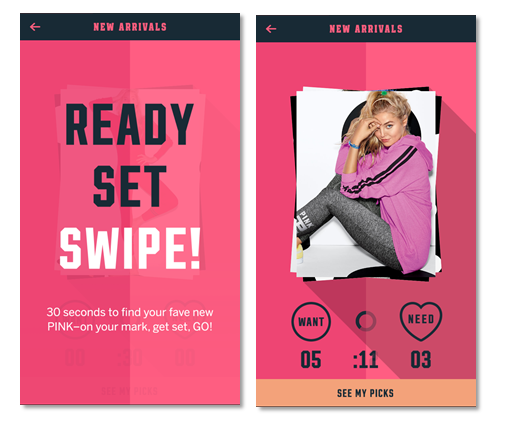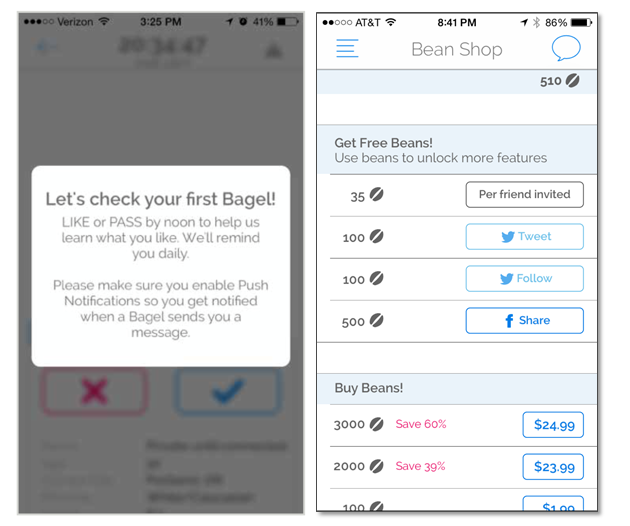What Retail Marketers Can Learn From Dating Apps’ Game Of Love
Dating apps use gamification & messaging tactics to form an essential engagement habit. Contributor Alyssa Meritt explores how other brands can do the same.
Dating apps are extremely successful at encouraging habitual use, and there’s more at play than Maslow’s hierarchy of needs. Over the past decade, online dating has evolved from “best match” algorithms into match-making entertainment based on gamification frameworks.
Gamification has been a hot topic in the mobile space for quite some time. It can help drive one-time actions, such as registration or purchase, or repeated interactions, such as media consumption or community reputation.
Paired with mobile messaging, gamification improves user engagement and loyalty while progressively gathering information to better serve app users in increasingly relevant and delightful ways.
So what can other apps learn from dating apps? Turns out, quite a few things. Our strategy consulting team identified four key strategies that spark enviable engagement for dating apps, and are equally as applicable to retail, media, travel, and health apps, to name a few.
1. Reward A Deepening Relationship By Giving Customers More
Dating apps such as eHarmony and OK Cupid ask users a series of questions to understand their interests, and they also track what they click. The result is that they can serve better matches to users, which encourages greater engagement.
Other apps mimic this feedback-engagement model through a preference center and learning from users’ behaviors, but dating apps take this one step further. OK Cupid incentivizes responses by unlocking additional matches when users answer more questions.
Users who take the time to set parameters on the person he or she is willing to date are likely to see better matches. Similarly, a shopper who shares her size or color preferences for clothing will be rewarded with more relevant offers, and perhaps a coupon incentive to purchase, too.
But messages don’t need to be limited to financial offers. Affirmation and status rank are powerful motivators on dating sites and on social tools such as LinkedIn, which reveal the relative strength of a profile in terms of popularity or search hits.
Another tactic to encourage users to build profiles revolves around assigning a percentage to the completeness of a profile. This encourages users’ curiosity about what tasks they need to tackle to achieve 100%. Segmented push or in-app messages can specifically target users who have only reached a certain point in customer onboarding.
Marketers can justify offering high-value tailored content or perks because the direct benefit to the brand is in total customer lifetime value vs. the cost of acquisition and onboarding for a new customer. Additionally, the insights from mobile can also be used cross-channel to create enhanced experiences in-store and on other platforms.
2. Gamify The Experience By Making Choice More Fun
Apps such as Tinder gamify the dating experience by providing an enormous pool of potential mates and letting the user self-curate by placing age and proximity limitations. Users can then swipe right to indicate interest. If the receiving party reciprocates, direct messaging is enabled through in-app messages.
Brands outside the dating industry can capitalize on this approach by building fun, breezy self-curation activities that reveal which products or content users are most interested in. This gives users an easy way to browse products, such as swiping to learn more about a piece of clothing or type of music, and gives brands an easy way to learn more about them.
A preference center might not reveal users’ true interests due to category limitations. Also, users might not want to take the time to indicate their preferences. However, by gamifying the feedback process, brands can learn from users’ behaviors and create segments to serve up targeted content.
For example, if a woman has browsed dresses and clicked on several in the color black, a savvy brand would infer she is likely looking for that perfect little black dress (or LBD) for date night.
The brand would then add this user to the LBD segment and send her a push notification or in-app message when a new selection of LBDs arrives.
3. Put A Name To A Face With Rich, Interactive Media
Visual appearances play a strong role in everyday life choices — what we eat, what we wear, who we are attracted to, and more. Top brands amp up their visual and interactive offerings, pairing curated content with interactive media, such as rich landing pages featuring a picture of that new little black dress with product information and a buy button.
The Victoria’s Secret PINK Nation app succeeds in gamifying the retail experience, and supporting the visual browsing experience with interactive media. The PINK Nation app uses a mini-game feature called “want or need” in the app to showcase products. The feature encourages the user to swipe left or right to identify their interest in different looks. After time’s up, PINK Nation shares the breakdown of how many “wants” vs. “needs” were selected, with clickable product information.
The app also uses playful elements such as a lotto-style scratch card and icons that reveal rewards or offers when traced. It also awards badges to users when they complete certain tasks.
As with dating apps, PINK Nation uses push messages as a way to prompt engagement, crafting the message content so there is a call-to-action paired with the payoff (such as unlocking a new freebie).
4. Curated Content Helps Drive Decisions
While gamification strategies excite users, messaging is key to delivering curated content to generate conversions. Brands need to realize the richer opportunity of going beyond reaching consumers anytime and anywhere, to reaching them with what matters most to them.
For example, “shopping” for love in a dating app isn’t much different from shopping for clothing in a retail app — in both instances, apps have an opportunity to learn a lot about a user’s preferences and behaviors and create rich segmentation profiles that can recommend good matches.
Sales psychology suggests that curation drives buying decisions, because people who are presented with a small number of choices are more likely to make a selection than those who are shown a plethora of options.
The Coffee Meets Bagel dating app (disclosure: my company’s client) succeeds in sending hand-picked prospects to its users for a more personal dating experience by integrating with Facebook. The free app will select one “bagel” for each user every day (who is a friend of a friend), favoring quality picks over quantity of choices. If both parties indicate interest, they are set up to chat and get to know each other. Coffee Meets Bagel also enables you to perform tasks or pay outright for unlocking features.
Curating suggestions based on users’ preferences and affinities prompts deeper consideration than a swath of options. The key is mapping the brand’s objective to the user experience, which can unlock massive benefit, enabling the promotion of new full-price items or promoted content in a way that is more likely to delight users.
Successful apps have a defined strategy that focuses on engaging users throughout their journey with the app, rewarding desired behaviors and customizing content based on users’ expectations. Taking a page from the playbook of some of the most popular dating apps can help you keep the romance alive with your app users.
Contributing authors are invited to create content for MarTech and are chosen for their expertise and contribution to the martech community. Our contributors work under the oversight of the editorial staff and contributions are checked for quality and relevance to our readers. The opinions they express are their own.
Related stories
New on MarTech



